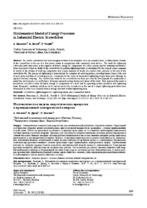| dc.contributor.author | Nieoczym, A. | |
| dc.contributor.author | Drozd, K. | |
| dc.contributor.author | Veselik, P. | |
| dc.coverage.spatial | Минск | ru |
| dc.date.accessioned | 2019-07-04T10:30:00Z | |
| dc.date.available | 2019-07-04T10:30:00Z | |
| dc.date.issued | 2019 | |
| dc.identifier.citation | Nieoczym, A. Mathematical Model of Energy Processes in Industrial Electric Screwdriver = Математическая модель энергетических процессов в промышленной электрической отвертке / A. Nieoczym, K. Drozd, P. Veselik // Наука и техника. – 2019. – № 3. – С. 209-215. | ru |
| dc.identifier.uri | https://rep.bntu.by/handle/data/54319 | |
| dc.description.abstract | An electric screwdriver has been designed to work in an automatic cycle on assembly lines. A characteristic feature of the screwdriver is the use of a low power motor in comparison with commonly used devices. The work for tightening a threaded joint takes place at the expense of kinetic energy in components of a drive system and the working screwdriver. It has been proved that an ability of the screwdriver to perform tightening works is determined by the sum of a mass moment of inertia in the system of working components and a mass moment of inertia in a motor rotor, reduced to the axis of the screwdriver bit. The process of tightening is characterized by a number of screwing pulses, screwing torque values at the end of each pulse and time of screwing process. Limitation for the value of transmitted tightening torque takes place through an applied overload coupling. The construction work for the screwdriver has been preceded by development of a mathematical model for screwing process and balance of torque moments acting during each phase of the work. Such approach has made it possible to calculate a value of kinetic energy in components of a drive and an operating system converted into tightening work. Kinematic conditions which are to be carried out by the screwdriver at the end of a single tightening pulse have been determined in order to accumulate kinetic energy and start another tightening pulse. | ru |
| dc.language.iso | en | ru |
| dc.publisher | БНТУ | ru |
| dc.title | Mathematical Model of Energy Processes in Industrial Electric Screwdriver | ru |
| dc.title.alternative | Математическая модель энергетических процессов в промышленной электрической отвертке | ru |
| dc.type | Article | ru |
| dc.identifier.doi | 10.21122/2227-1031-2019-18-3-209-215 | |
| local.description.annotation | Электрическая отвертка была разработана для автоматической работы на сборочных линиях. Характерной особенностью отвертки является использование двигателя малой мощности по сравнению с обычно применяемыми устройствами. Работа по натяжению резьбового соединения происходит за счет кинетической энергии компонентов системы привода и рабочей отвертки. Доказано, что способность отвертки выполнять затяжные работы определяется суммой массового момента инерции системы рабочих компонентов и массового момента инерции ротора двигателя, приведенного к оси наконечника отвертки. Процесс затягивания характеризуется количеством импульсов завинчивания, значениями момента завинчивания в конце каждого импульса и временем процесса завинчивания. Ограничение величины передаваемого момента затяжки происходит через применяемую перегрузочную муфту. Строительным работам по отвертке предшествовала разработка математической модели процесса завинчивания и балансировки крутящих моментов, действующих на каждом этапе работы. Это позволило рассчитать значение кинетической энергии компонентов привода и операционной системы в переводе на затяжные работы. Кинематические условия, которые должны быть выполнены отверткой в конце одного импульса затяжки, были определены для накопления кинетической энергии и запуска другого импульса затяжки. | ru |

